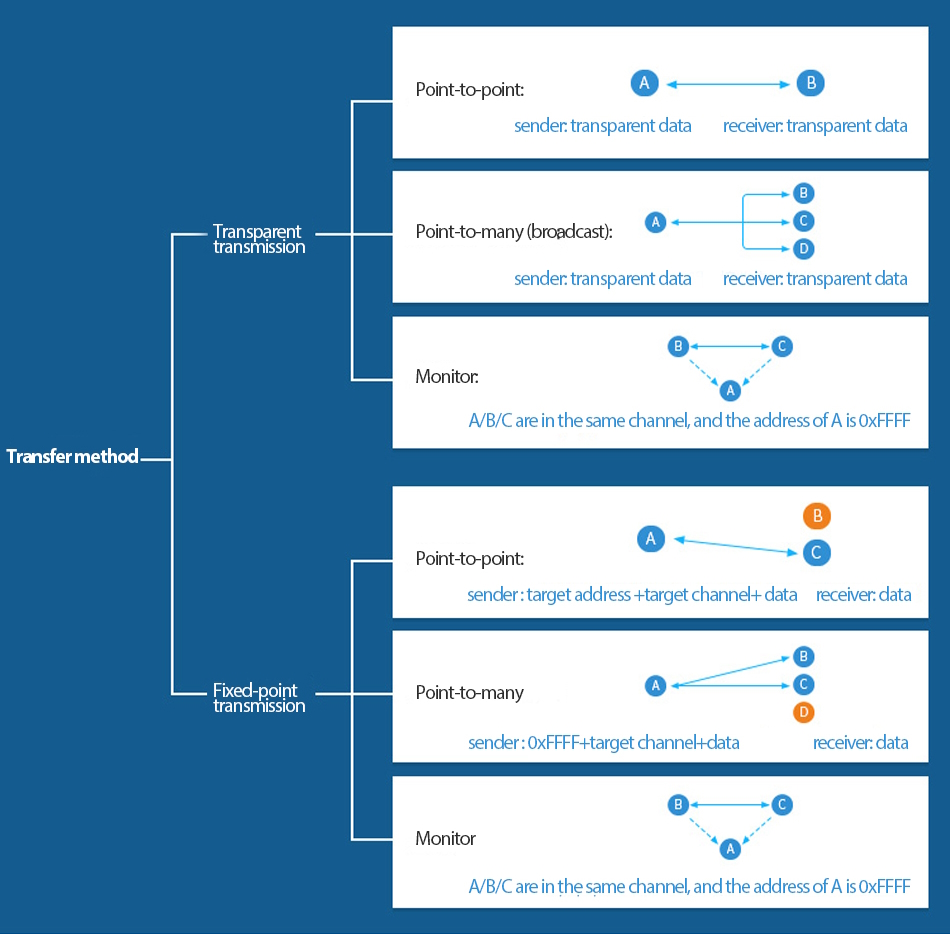E32 Modules
Wiring
E32 Module |
MCU |
|---|---|
M0 |
Any digital output pin |
M1 |
Any digital output pin |
RXD |
Any UART TX capable pin* |
TXD |
Any UART RX capable pin* |
AUX |
Any digital input pin** |
VCC |
Power supply |
*: Some devices may require you to use very specific pins for the UART bus.
**: This pin can be left floating, but the module’s AUX response times will be estimated and inaccurate.
***: Should be between 3.3V and 5.0V for less than 5W, more than 5.2V can cause damage, and some modules support 2.3V !
Model Number Structure
The E32 modules all have a unique name that gives you some information about its abilities, form factor and more.
Here is the standard format:
E32-{Frequency}{Interface}{TX Power Max dBm}{Form Factor}{Optional Variant}
Frequency
170 ➜ 160-173.5 MHz
400 ➜ 410-525 MHz
433 ➜ 410-441 MHz
868 ➜ 862-893 MHz
900 ➜ 862-931 MHz
915 ➜ 900-931 MHz
Interface
T ➜ UART
M ➜ SPI
Max Power
20 ➜ 20dBm / 100mW
30 ➜ 30dBm / 1W
33 ➜ 33dBm / 2W
37 ➜ 37dBm / 5W (Special PSU requirements)
Form Factor
D ➜ DIP (Dual In-line Package)
S ➜ SMD (Surface Mount Device)
Optional Variant
The optional variant can be a number that may have a letter after it, or just a letter:
1, 2, 2T, 3, C, T
I don’t know what the letter mean for sure, it could be related to the minimum voltage input since it seems to be different on those.
Supported Modules
Model |
Max TX Power |
Frequencies |
Chipset |
|---|---|---|---|
|
30 dBm / 1 W |
160-173.5 MHz |
SX1278 |
|
20 dBm / 100 mW |
410-525 MHz EU443 CN470-510 |
|
|
20 dBm / 100 mW |
410-441 MHz EU433 |
|
|
30 dBm / 1 W |
||
|
33 dBm / 2W |
||
|
37 dBm / 5W |
||
|
20 dBm / 100 mW |
862-893 MHz EU863-870 IN865-867 |
SX1276 |
|
30 dBm / 1 W |
||
|
20 dBm / 100 mW |
862-931 MHz EU863-870 IN865-867 AS920-923 (“AS1”) AS923-925 (“AS2”) AU915-928 KR920-923 US902-928 |
|
|
30 dBm / 1 W |
||
|
20 dBm / 100 mW |
900-931 MHz AS920-923 AU915-928 (“AS1”) AS923-925 (“AS2”) KR920-923 US902-928 |
|
|
30 dBm / 1 W |
All frequencies with a {Region}xxx-yyy code used for LoRaWAN depending on your location.
The E32-400 and E32-900 variants support more channels per modules.
Unsupported Modules
Model |
Max TX Power |
Frequencies |
Chipset |
|---|---|---|---|
|
20 dBm / 100 mW |
433/470MHz |
SX1278 |
|
30 dBm / 1 W |
||
|
??? |
??? |
??? |
|
20 dBm / 100 mW |
868/915MHz |
SX1276 |
|
30 dBm / 1 W |
The E32-***M**S variants has very basic datasheets, no concrete frequencies could be found.
The E32-433T27D variant is mentioned in the E32 V1.30 User Manual,
and on its product page
but no proper datasheet could be found for it.
Transmission Modes
The E32 modules support 2 modes of communication named “Transparent” and “Fixed”.
The main characteristic of “Fixed” mode is that it requires you to prepend you message with a target address and channel.
And for “Transparent” mode, you can broadcast as well as monitor.
Please note that Ebyte’s infographic shown below doesn’t state that modules in “Transparent” modes needs to be set on the same channel and address, but you absolutely need to.

E32 Transmission modes. Credit: Ebyte's official store on aliexpress.com
Datasheets
All datasheets are hosted by Ebyte on ebyte.com and cdebyte.com unless specified otherwise.
E32-433T33S (manualslib.com)
If any datasheet becomes unavailable, please open an issue.
We also keep copies of them over at files.nibblepoker.lu
just in case.
Alternatively, manualslib.com has a pretty good collection of the most common ones.